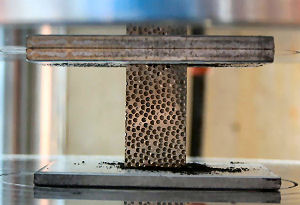17 July 2015
Innovative lightweight metal foam set to protect astronauts
by Will Parker
 Lightweight composite metal foams are effective at blocking X-rays, gamma rays and neutron radiation, say researchers from North Carolina State University who believe their discovery holds promise for use in nuclear safety and space exploration.
Lightweight composite metal foams are effective at blocking X-rays, gamma rays and neutron radiation, say researchers from North Carolina State University who believe their discovery holds promise for use in nuclear safety and space exploration.
"This work means there's an opportunity to use composite metal foam to develop safer systems for transporting nuclear waste, more efficient designs for spacecraft and nuclear structures, and new shielding for use in CT scanners," says Afsaneh Rabiei, a professor of aerospace engineering at NC State and co-author of a paper on the work.
Rabiei first developed the strong, lightweight metal foam for use in transportation and military applications. But she wanted to determine whether the foam could be used for nuclear or space exploration applications - could it provide structural support, protect against high impacts and provide shielding against various forms of radiation?
To that end, she and her colleagues conducted multiple tests to see how effective it was at blocking X-rays, gamma rays and neutron radiation. She then compared the material's performance to the performance of bulk materials that are currently used in shielding applications. The comparison was made using samples of the same "areal" density - meaning that each sample had the same weight, but varied in volume.
The most effective composite metal foam against all three forms of radiation is called "high-Z steel-steel" and was made up largely of stainless steel, but incorporated a small amount of tungsten. However, the structure of the high-Z foam was modified so that the composite foam that included tungsten was not denser than metal foam made entirely of stainless steel.
The researchers tested shielding performance against several kinds of gamma ray radiation. Different source materials produce gamma rays with different energies. For example, cesium and cobalt emit higher-energy gamma rays, while barium and americium emit lower-energy gamma rays.
The researchers found that the high-Z foam was comparable to bulk materials at blocking high-energy gamma rays, but was much better than bulk materials - even bulk steel - at blocking low-energy gamma rays.
Similarly, the high-Z foam outperformed other materials at blocking neutron radiation and performed better than most materials at blocking X-rays, but was not quite as effective as lead.
"However, we are working to modify the composition of the metal foam to be even more effective than lead at blocking X-rays - and our early results are promising," Rabiei says. "And our foams have the advantage of being non-toxic, which means that they are easier to manufacture and recycle. In addition, the extraordinary mechanical and thermal properties of composite metal foams, and their energy absorption capabilities, make the material a good candidate for various nuclear structural applications."
Related:
Discuss this article in our forum
Spacesuits get skintight makeover
Space station experiment identifies microbes that can survive unprotected in space
Plastic could work as shield against space radiation hazards
Source: North Carolina State University
